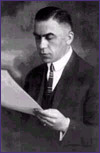Friedrich Wilhelm Hollstein (1888-1957)

The publisher who finally brought out Hollstein's first catalogue was Menno Hertzberger. The initiative was greeted enthusiastically throughout the print world. Hollstein's numbering was immediately adopted in the catalogues of auction houses and print dealers, while many printrooms rearranged their holdings in Hollstein order as each new volume appeared.
Dating from 1949 is F.W.H. Hollstein's Dutch & Flemish Etchings, Engravings and Woodcuts ca. 1450-1700, and from 1954 the parallel series German Engravings, Etchings and Woodcuts ca. 1400-1700. When Hollstein died in 1957, fourteen volumes had appeared on Dutch and Flemish prints and five on German prints. Work on the series came to a virtual standstill.The new editor, K.G. Boon of the Rijksmuseum printroom, and successive editors incorporated the improvements they felt necessary in order to bring the catalogues up to standard.Boon, which were published in 1969, the work was based not just on older references and visits to a few collections, but as far as possible on the fullest coverage of all the major European printrooms.
The entries were improved so that users could clearly distinguish between different prints and their states, and the inscriptions on the plates were reproduced more completely and accurately. From volume 15, moreover, the work of all printmakers has been catalogued to the same peintress-graveurs, or engravers who worked after designs by other artists.Since the volumes on Rembrandt by Christopher White and Boon, which were published in 1969, the work was based not just on older references and visits to a few collections, but as far as possible on the fullest coverage of all the major European printrooms. The entries were improved so that users could clearly distinguish between different prints and their states, and the inscriptions on the plates were reproduced more completely and accurately. From volume 15, moreover, the work of all printmakers has been catalogued to the same peintress-graveurs, or engravers who worked after designs by other artists.Under Boon's editorship, most volumes were compiled by D. de Hoop Scheffer, Keeper of prints at the Rijksmuseum, and Georges S. Keyes.
The former took over as editor in 1985, and has closely supervised the work of the successive compilers, Ger Luijten and Christian Schuckman.Since the taking over by Sound & Vision Publishers the two new series, the New Hollstein Dutch & Flemish and the New Hollstein German series, were launched in earnest. The new series are intended as revised editions of the earlier volumes in Hollstein's Dutch & Flemish series and in Hollstein's German series. With the replacement of these early volumes, Hollstein and the New Hollstein together will constitute a catalogue unique in its completeness and ease of use. One of the aspects warranting the revision is that scholarly thinking as to what constitutes a graphic oeuvre has changed. Whereas the execution of the wood or metalwork was long considered the mark of authorship of a print, a new generation of scholars is placing increasing emphasis on the role of the designers, who were not always the executors. The aim is to create an instrument for a balanced investigation of the inventor, the peintre-graveur and the reproductive printmaker and their respective contributions to the history of printmaking.

